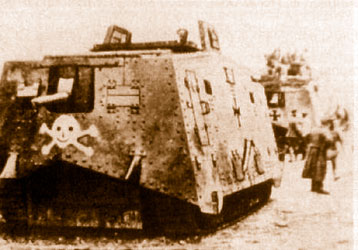Second battle of Villers-Bretonneux
La première bataille entre chars de l'histoire eut lieue le 24 avril 1918, lors de la deuxième bataille de Villers-Bretonneux (bataille de la Lys, 24-27 avril 1918, offensive allemande contre les lignes britanniques devant Amiens). Ce jour là, trois A7Vs accompagnèrent un assaut de l'infanterie allemande et rencontrèrent 3 Mark IVs britanniques (2 Females et 2 Males) près de ce village picard (département de la Somme) capturé par les Allemands. Durant cet affrontement plusieurs chars des deux camps furent endommagés. Un des Mark IV Females fut stoppé et endommagé par des balles perforantes. Les chars Females, armés seulement de mitrailleuses n'avaient pas réussis à endommager les A7Vs, alors le 2nd Lt Mitchell attaqua avec succès celui de tête (commandé par le 2nd Lt Wilhelm Blitz) avec les canons de 6-pdr de son char Male. L'A7V fut atteint à trois reprises et 5 hommes furent tués. Les deux autres A7Vs se retirèrent du combat. L'infanterie allemande fut ensuite attaquée par sept Medium Tank Mark A Whippet. Quatre Whippets furent perdus lors de l'affrontement. Le Mark IV Male de 2nd Lt Mitchell perdit une chenille à la fin de la bataille à cause d'un obus de mortier et le char fut abandonné. L'A7V du 2nd Lt Blitz fut lui récupéré par les Allemands.
The first battle between tanks of history took place on April 24, 1918, at the time of the second battle of Villers-Bretonneux (period of the battle of Lys, 24-27 April 1918, German offensive against British lines in front of Amiens). This day there, three A7Vs accompanied an attack of German infantry and met 3 British Mark IVs (2 Females and 2 Males) close to this Picardy village (department of the Sum) captured by Germans. During this confrontation several tanks of the two camps were damaged. One of the Mark IV Females was stopped and damaged by perforating bullets. The Females tanks, armed only with machine-guns had not succeeded to damage A7Vs, then the 2nd Lt Mitchell successfully attacked that of head (commanded by the 2nd Lt Wilhelm Blitz) with the guns of 6-pdr of his Male tank.The A7V was reached with three projectiles and 5 men were killed. Both other A7Vs withdrew combat. The German infantry was then attacked by seven Medium Tanks Mark A Whippet. Four Whippets were lost at the time of the confrontation. Mark IV Male of 2nd Lt Mitchell lost a track at the end of the battle because a mortar round and the tank was abandoned. The A7V of the 2nd Lt Blitz was it recovered by the Germans.
 |
 |
A7V |
Mark IV Male |
src:
site WW1
History (Suite 101) |
src: Great
Britain Tanks |
Tous les A7Vs disponibles (13 en tout, le plus grand déployement de chars allemands de la guerre) furent utilisés durrant la bataille. Les résultats furent très limités; deux tombèrent dans des fosses, quelques-uns rencontrèrent des problèmes mécaniques et d'armement. Après une contre-attaque des Alliés, trois A7Vs furent capturés. Sur ces trois chars, un fut donné aux Australiens, un fut récupéré par les Français pour des exercices de tirs et le dernier totalement détruit fut ferraillé.
All A7Vs available (13 in all, largest déployement of German tanks of the war) were used in the combat durant the battle. The results were very limited; two fell into holes, some encountered mechanical and armament problems. After a counter-attack of the Allies, three A7Vs were captured. On these three tanks, one was given to the Australians, one was recovered by the French for firing practices and thelast completely destroyed was scrapped.
 |
Medium A Whippet
|
src: Great
Britain Tanks
|
